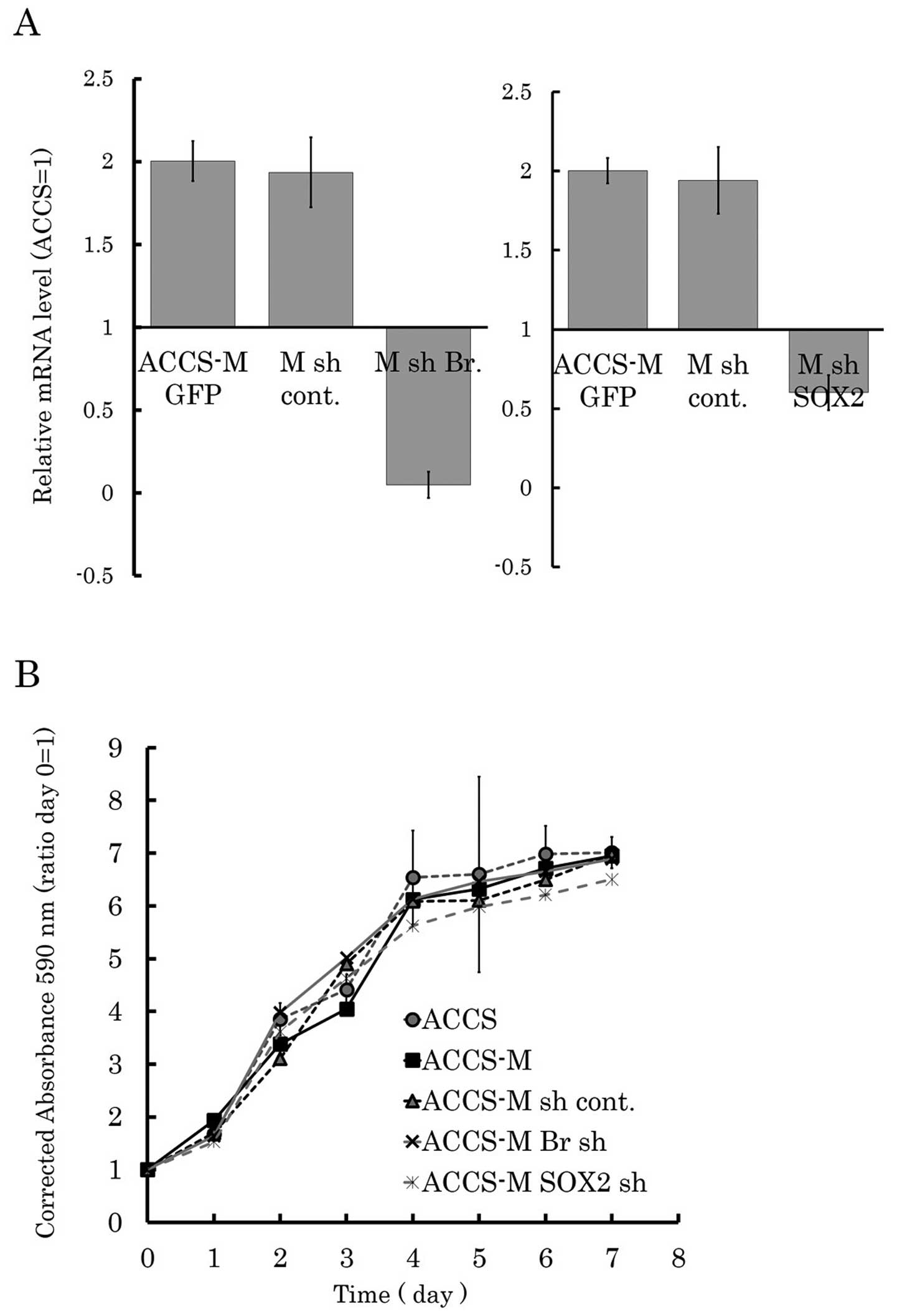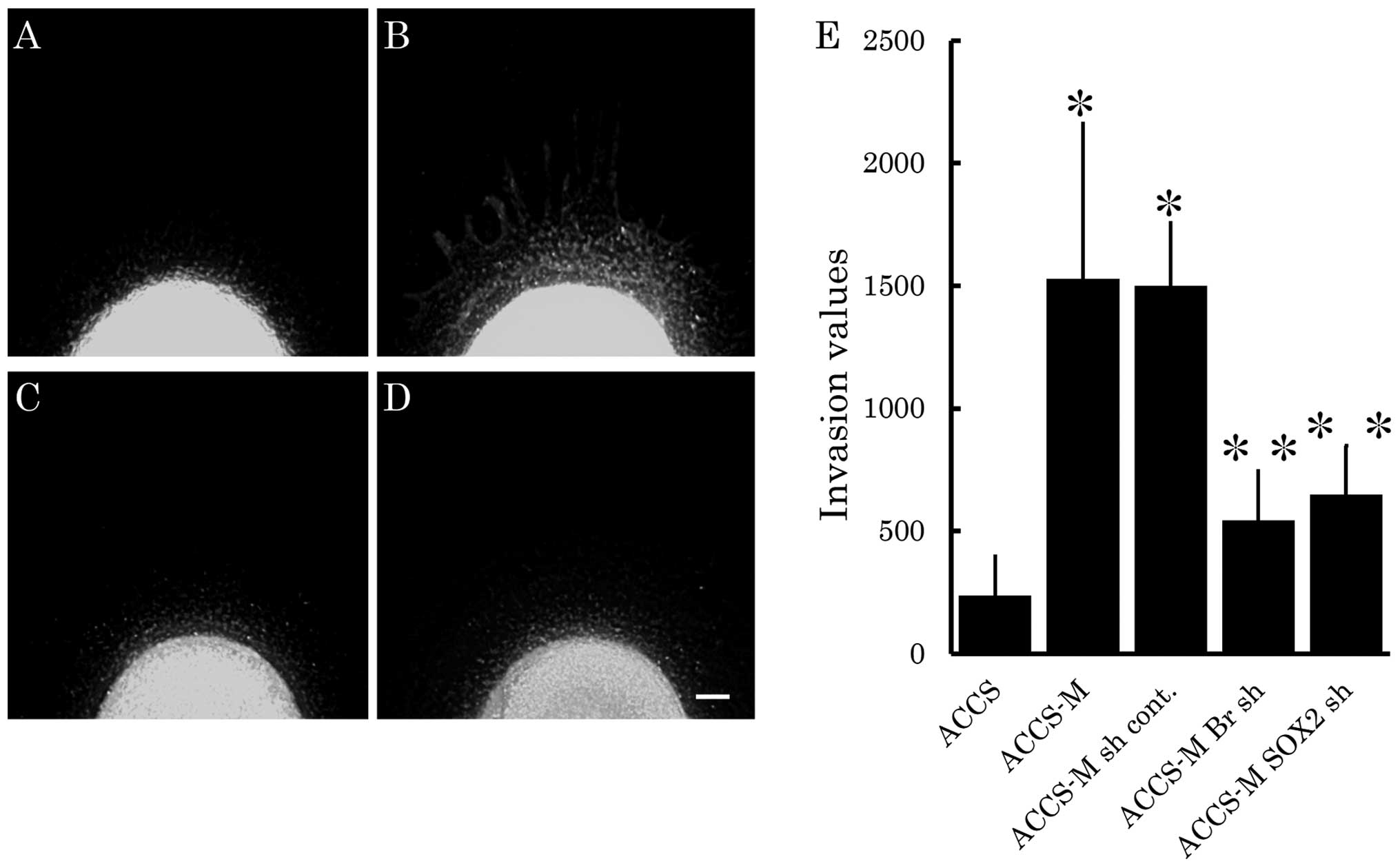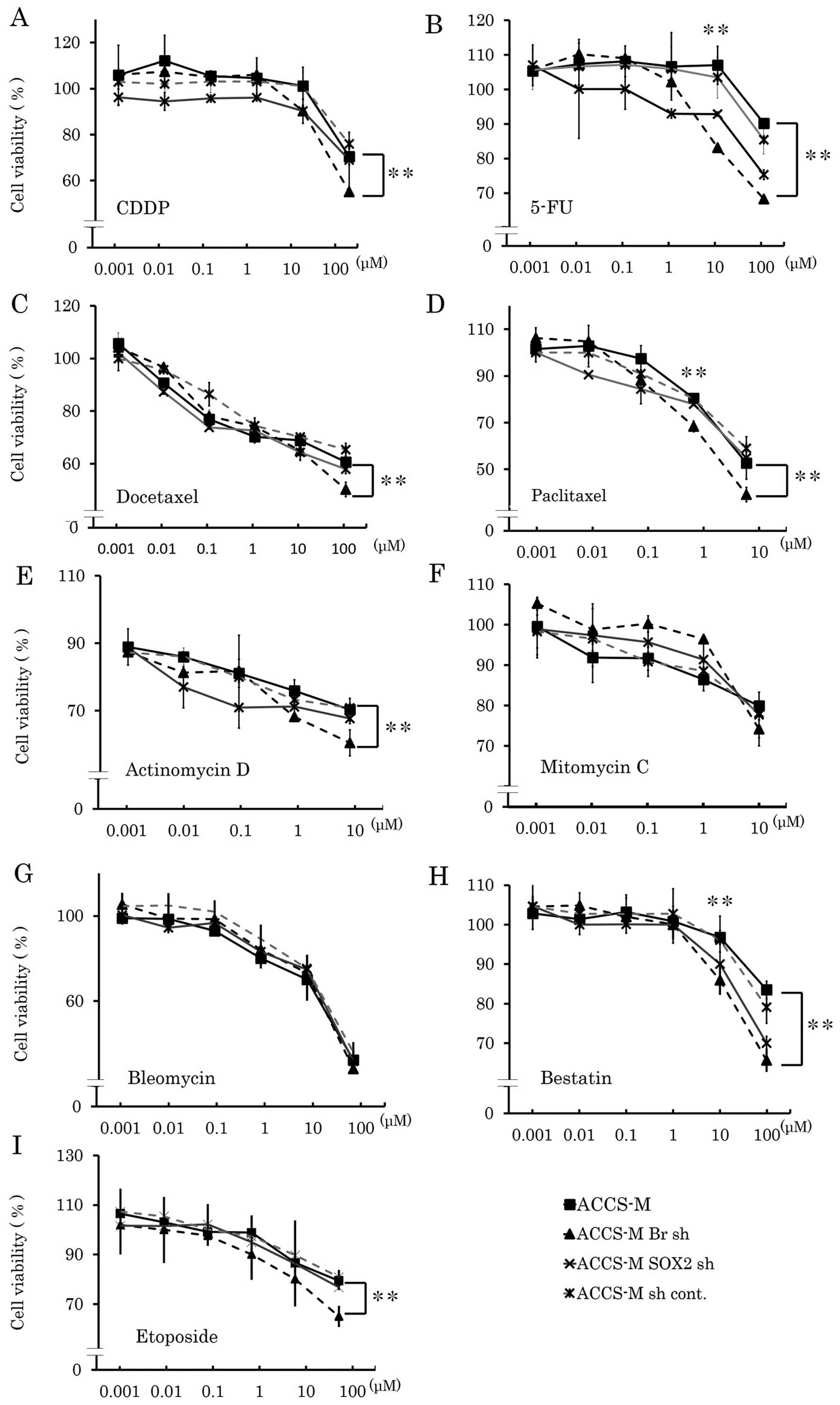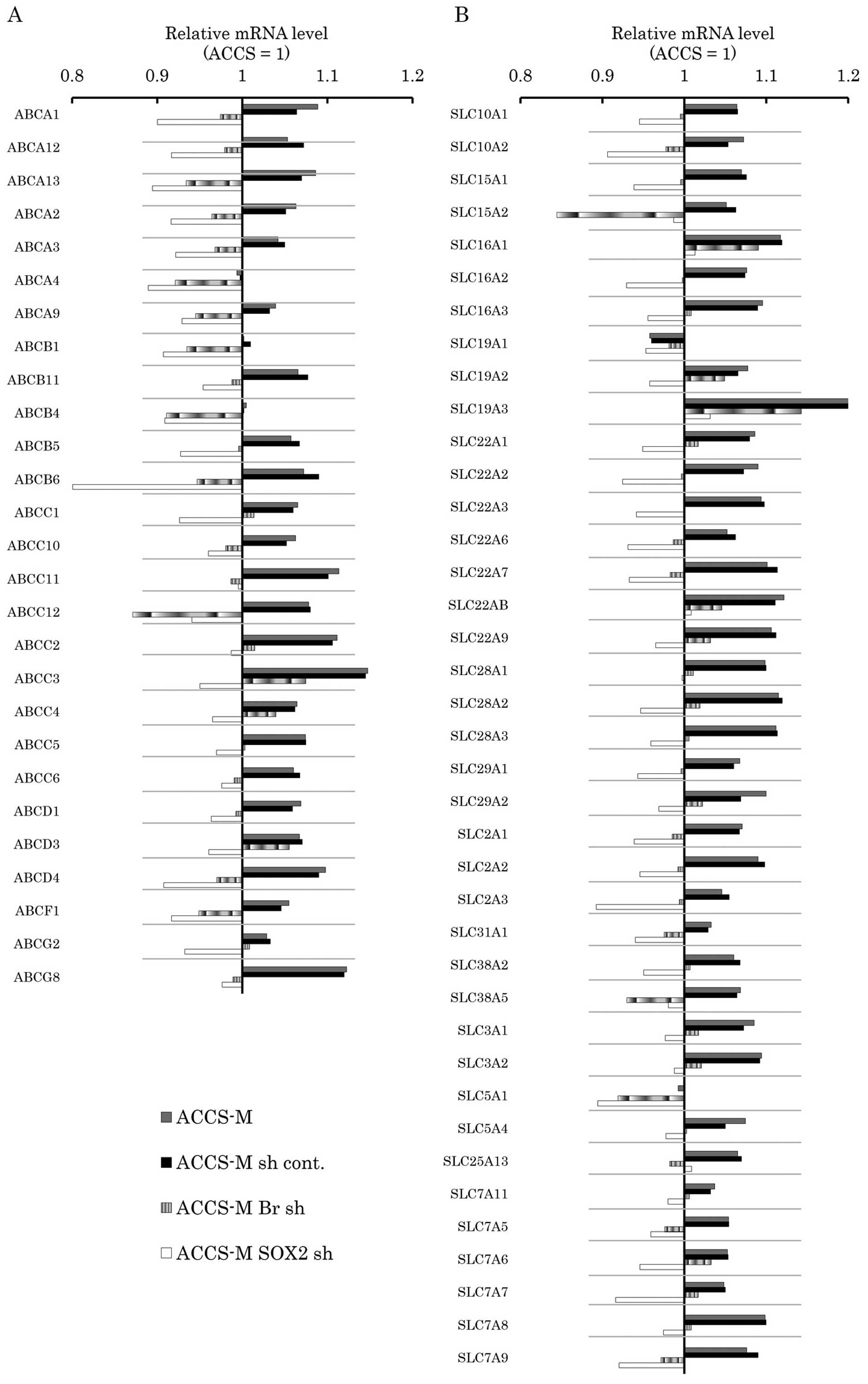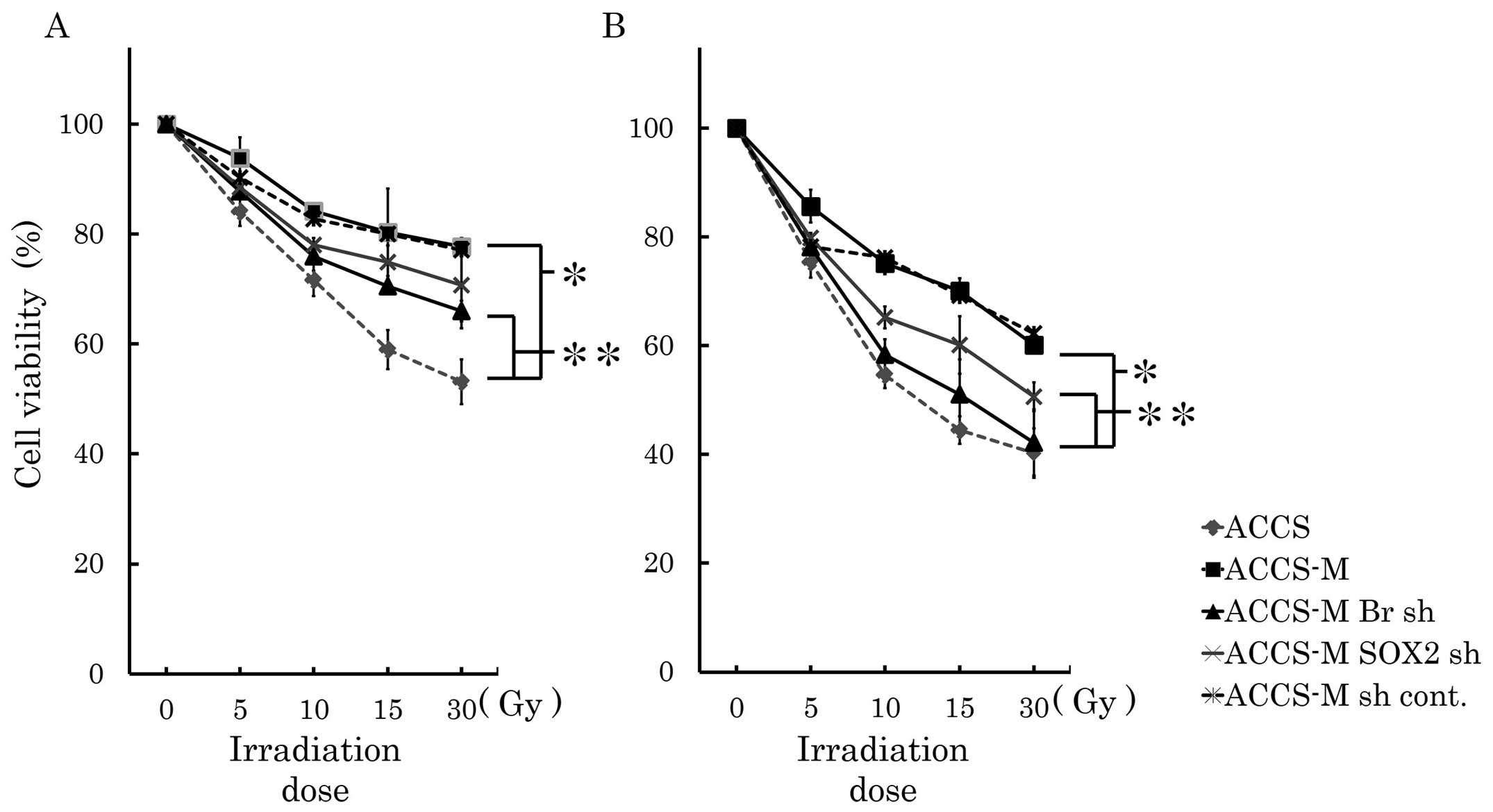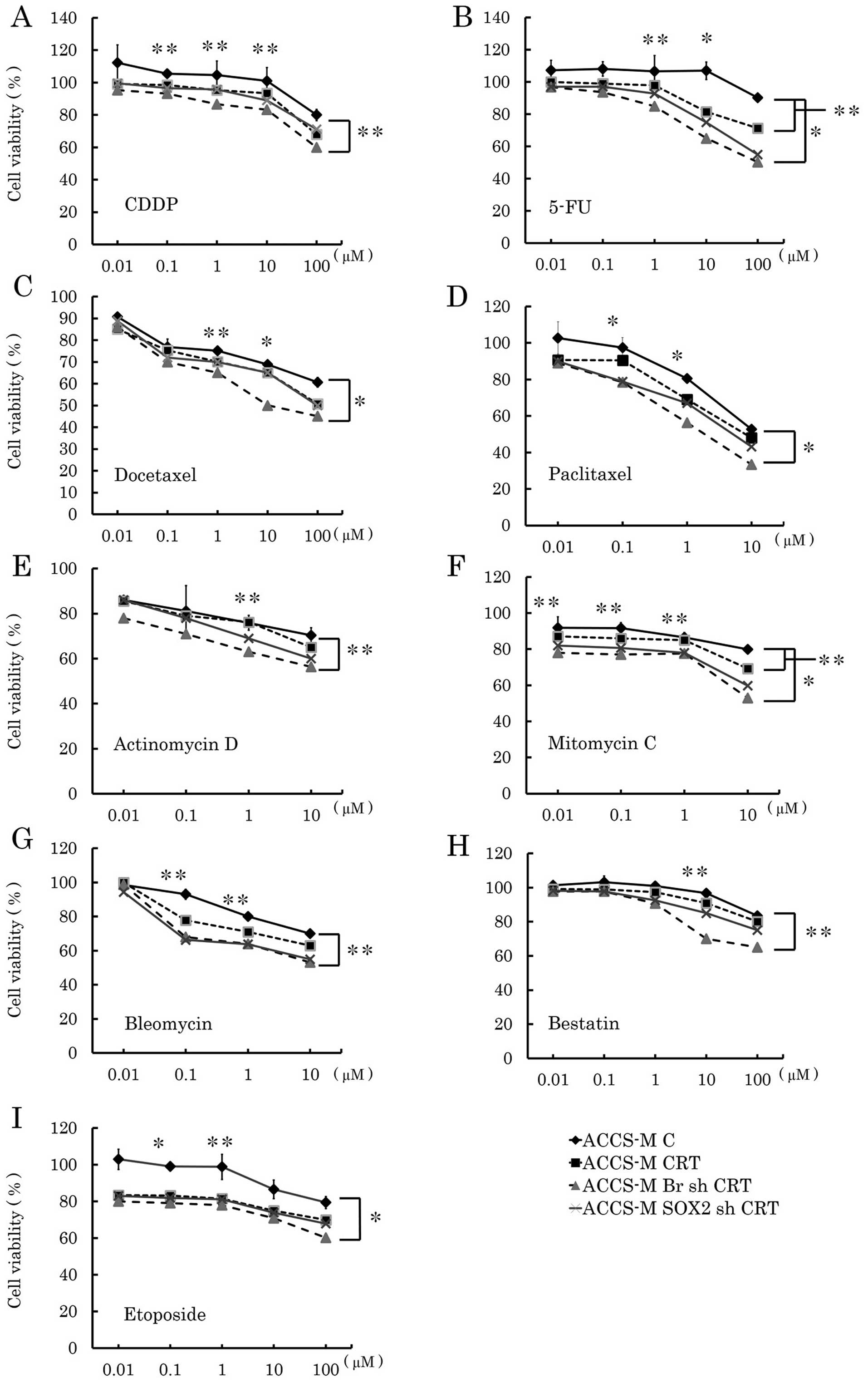Knockdown of the T-box transcription factor Brachyury increases sensitivity of adenoid cystic carcinoma cells to chemotherapy and radiation in vitro: Implications for a new therapeutic principle
- Authors:
- Published online on: February 6, 2014 https://doi.org/10.3892/ijo.2014.2292
- Pages: 1107-1117
-
Copyright: © Kobayashi et al. This is an open access article distributed under the terms of Creative Commons Attribution License [CC BY_NC 3.0].
Abstract
Introduction
Adenoid cystic carcinoma (AdCC) is among the most common malignant tumors of the salivary glands and is characterized by unique clinical features and behavior. Although slow growing, AdCC spreads relentlessly into adjacent tissues. It carries a high risk of recurrence and distant metastases, with 40–60% of afflicted patients developing distant metastases to the lungs, bone, and soft tissues (1,2). AdCC is resistant to chemotherapy and radiotherapy. Therefore, treatment-resistant distant metastases remain a significant obstacle to the long-term cure of patients with AdCC, emphasizing the need for anti-metastasis therapy for AdCC.
We previously established 3 AdCC cell lines that express green fluorescent protein (GFP) from the ACCS cell line using orthotopic transplantation and in vivo selection in the nude mouse. These 3 lines include the parental ACCS GFP, the highly tumorigenic ACCS-T GFP, and the metastatic ACCS-M GFP line. We demonstrated that ACCS-M GFP cells exhibited a loss of E-cadherin and integrins and a gain in vimentin, suggesting that the epithelial-mesenchymal transition (EMT) is a key event in AdCC metastasis that induces tumor cell dissemination from the primary tumor site (3). We also showed a direct correlation between EMT and prevalence of cancer stem cell-like cells in AdCC (4).
The EMT program triggered during tumor progression appears to be controlled by expression of early embryonic genes, including Twist, Snail, Slug, Goosecoid and SIP1 (5,6). The transcription factors encoded by these genes impart mesenchymal traits to tumor cells, including motility and invasiveness. For example, expression of Twist is elevated in various cancers, including breast, prostate, gastric and melanoma (7). In addition, the T-box transcription factor Brachyury, a protein required for mesoderm formation during development (8–10), reportedly promotes EMT in human carcinoma cell lines (11). The latter study also showed that Brachyury overexpression in human carcinoma cells induced changes characteristic of EMT. These findings suggest that the EMT in cancer cells is controlled by mechanisms similar to the EMT during normal human development.
Other studies using neoplastic tissue have identified self-renewing, stem-like cells within tumors, referred to as cancer stem cells (CSCs). CSCs constitute a minority of neoplastic cells within a tumor and are defined operationally by their ability to seed new tumors. For this reason, they have also been termed tumor-initiating cells (12). During the process of tumor metastasis, which is often enabled by EMT (13), disseminated cancer cells are thought to require self-renewal properties similar to those exhibited by stem cells in order to spawn macroscopic metastases. This raises the possibility that the EMT process, which enables cancer cell dissemination, may also impart self-renewal to disseminating cancer cells. Indeed, emerging evidence of a direct interaction between EMT and CSCs (11,14,15). Similarly to normal stem cells, CSCs are regulated by key genes, such as Oct4, Nanog, c-Myc, Sox2, and Klf4, which are similar to EMT-regulator genes (16,17). CSCs are resistant to chemotherapy and radiotherapy (18,19), suggesting a new therapeutic principle for targeting CSCs (20,21).
We have confirmed a direct interaction between the EMT and CSCs in the highly metastatic AdCC subclone ACCS-M GFP. We also reported that the T-box transcription factor Brachyury, which is also a marker of mesoderm differentiation (22,23), regulates CSC and the EMT in AdCC cells. Brachyury knockdown exerted a stronger effect on cancer sternness and EMT phenotype than did knockdown of the conventional CSC regulator gene, Sox2. By reducing the sternness of CSCs, Brachyury knockdown significantly inhibited tumorigenicity and metastasis in vivo (4). This hypothesis has been supported by recent evidence linking Brachyury to CSCs in colon cancer (24).
These observations suggest that knocking down Brachyury can control CSC and EMT, thus inducing CSC differentiation and sensitization to conventional chemotherapy and radiotherapy. In this study, we validated that Brachyury knockdown suppresses chemo- and radioresistance in vitro as a first step in establishing its therapeutic potential against CSCs.
Materials and methods
Chemicals
Standard anticancer drug kits were provided by Scientific Support Programs for Cancer Research, Grant-in-Aid for Scientific Research on Innovative Areas from the Ministry of Education, Culture, Sports, Science and Technology of Japan. Docetaxel, 5-fluorouracil (5-FU), pacli-taxel, cisplatin (CDDP), mitomycin C, bestatin hydrochloride, bleomycin sulfate and etoposide were purchased from Sigma-Aldrich (St. Louis, MO, USA). Actinomycin D and streptomycin-SP were purchased from Calbiochem (Merck, Darmstadt, Germany).
Cells and cell culture
The human cell lines ACCS, ACCS GFP and ACCS-M GFP were established in our laboratory as previously described (3). Briefly, the parental cell line ACCS and the GFP-transfected sub-line ACCS GFP displayed similar morphology, growth rate and tumorigenicity in vitro and in vivo. Similar to the parental ACCS cells, ACCS GFP cells had low tumorigenicity (22.2% incidence). Using ACCS GFP cells injected into the tongue of nude mice, tumor formation was observed under the excitation wavelength. Green fluorescence was not observed in the absence of tumors. We performed in vivo selection of clones with higher tumorigenicity by repeatedly recovering cells in vitro and transplanting them into the tongue of nude mice. This selection process yielded a subline exhibiting high tumorigenicity (100% incidence) and high frequency of metastasis to submandibular lymph nodes (100% incidence); these cells were termed ACCS-M GFP. The histological and immunohistochemical features of ACCS-M GFP tumors were similar to the solid pattern of AdCC. The cell lines were maintained as a monolayer culture in Dulbecco’s modified Eagle’s medium (DMEM; Sigma-Aldrich) supplemented with 10% fetal bovine serum (FBS; ICN Biomedicals, Aurora, OH, USA), 2 mM 1-glutamine, penicillin G, and streptomycin in a humidified incubator under an atmosphere of 5% CO2 at 37°C (3).
Transfection of Brachyury and SOX2 shRNA
Cultured ACCS cells were transfected with short hairpin RNA (shRNA) lentiviral plasmids (pLKO.l-puro; Sigma-Aldrich) using Lipofectamine LTX (Invitrogen Life Technologies, Carlsbad, CA, USA) according to the manufacturer’s instructions as previously described (4). ACCS-M sh cont. cells were generated by transfecting ACCS-M GFP cells with pLKO.l-puro Control shRNA Vector (Sigma-Aldrich). ACCS-M shBr and ACCS-M shSOX2 cells were generated by transfecting ACCS GFP and ACCS-M GFP cells with pLKO.l-puro/sh. Brachyury or pLKO.l-puro/sh. SOX2 (Sigma-Aldrich), respectively. Colonies resistant to puromycin (Sigma) were pooled from the individual transfection experiments. The expression level of Brachyury in shRNA-transfected ACCS cells was monitored by real-time reverse transcription-PCR (RT-PCR) (4). All transfected cells were maintained in DMEM containing 10% FBS and 2μg/ml puromycin (Sigma-Aldrich).
Wound healing assay
Cells (3×l05) were seeded on a 6-well plate. After 24 h, ‘wounds’ were scratched with a 200-μl pipette tip, washed with medium and observed under a fluorescence microscope (BZ-8000; Keyence, Osaka, Japan). The wound regions were photographed again after 8, 16 and 24 h, and the wound areas were measured. Wound area was calculated using the following formula: wound area (% of control) = (wound area after the indicated period × l00)/initial wound area.
Evaluation of tumor dissemination from the primary cancer nest
Evaluation of tumor dissemination from the primary cancer nest was performed as previously described (25). Briefly, living ACCS cell lines were fluorescently labeled using Vybrant DiO and DiD cell-labeling solutions (Molecular Probes, Eugene, OR, USA) according to the manufacturer’s instructions. Then, l×l06 labeled cells were pelleted and resuspended in 10 μl collagen type I gel to form a solid cell cluster. The collagen-embedded tumor cell pellets were allowed to solidify for 30 min at 37°C in a 100-μl microcentrifuge tube; the pellets were then embedded in non-labeled fibroblasts containing collagen type I gel (1×105 cells/ml) and solidified. Growth medium was placed over the collagen gels and cultured. Tumor dissemination was observed under a fluorescence microscope (BZ-8000; Keyence). The grade of tumor dissemination from the tumor cell pellet (modeling the primary tumor nest) was evaluated by measuring the distance of all cells from the edge of the nest in 5 randomly selected, standardized rectangular light fields (500×100 μm), and the values were summed. The evaluation was conducted twice daily for 7 days.
MTT assay
ACCS cell lines were seeded into CellTiter 96 Aqueous Non-radioactive Cell Proliferation Assay G4000 plates (Promega, Madison, WI, USA) at a density of 5×l03 cells per well and incubated in DMEM containing 10% FBS for 8 h. The medium was replaced with serum-free DMEM after 3 washes with PBS. For chemosensitivity analysis, a dilutional series of anticancer drugs was applied at final drug concentrations of 0, 0.001, 0.01, 0.1, 1, 10, 100 and 1,000 μM and incubated for 24 h in a humidified incubator under an atmosphere of 5% CO2 at 37°C. For radiosensitivity analysis, in vitro gamma-ray irradiation was administered at 5,10,15, or 30 Gy with a Gammacell 40® Exactor Low Dose-Rate Research Irradiator (Best Theratronics, Ottawa, Canada), and cells were then incubated for 48 or 72 h in a humidified incubator under an atmosphere of 5% CO2 at 37°C. After incubation, ACCS cells were analyzed by CellTiter 96 Aqueous Non-radioactive Cell Proliferation Assay G4000 (Promega) according to the manufacturer’s instructions. The absorbance of samples at 590 nm (A590) was measured with a microplate reader (Model 680, Bio-Rad, USA). All experiments were carried out in triplicate and repeated 3 times.
Data were normalized to the untreated controls and reported as % viability. The IC50 (μM) values for cytotoxicity of the anticancer drug represents the concentration yielding 50% viability, which was determined from the concentration-viability curve. The concentration-viability curve was generated using a non-linear regression model with the Solver function of Microsoft Excel as previously described (26).
Real-time RT-PCR
Total RNA was extracted from ACCS GFP cells using the RNeasy Mini kit (Qiagen, Chats worth, CA, USA) and used for first-strand cDNA synthesis. The mRNA levels were quantified in triplicate using a real-time PCR system with the Brilliant SYBR Green qPCR kit (Stratagene, La Jolla, CA, USA) for Brachyury and Sox2 or the RT2 Profiler PCR Array (96-well format) for human drug transporters (Qiagen). Specific primers for Brachyury and Sox2 were: hBrachyury (F) 5’-TGCTGCAATCCCATGACA-3’, (R) 5’-CGTTGCTCACAGACCACA-3’; hSOX2, (F) 5’-TGG GTTCGGTGGTCAAGT-3’, (R) 5’-CTCTGGTAGTGCTG GGACA-3’. The PCR cycling conditions were 10 min at 95°C followed by 47 cycles at 95°C for 30 sec, 60°C for 30 sec, and 72°C for 60 sec. Dissociation curve analyses confirmed that the signals corresponded to unique amplicons. Expression levels were normalized to (β-actin mRNA levels for each sample obtained from parallel assays and analyzed using the LightCycler software package version 3.5 (Roche Diagnostics, Mannheim, Germany) for hBrachyury and hSOX2 and Mx 3000P QPCR system (Agilent Technologies, CO, USA) for the RT2 Profiler PCR Array.
Statistical analysis
All data are represented as mean ± SD, as analyzed via analysis of variance and Student’s t-test, and processed using the statistical software SPSS 13.0. Statistical significance was defined as P<0.05.
Results
Brachyury and SOX2 shRNA do not influence growth of ACCS cell lines
We established ACCS GFP and ACCS-M GFP-derived cell lines by stable transfection of Brachyury or SOX2 shRNA lentiviral plasmids. The expression level of Brachyury or SOX2 in shRNA-transfected ACCS cells was monitored by real-time RT-PCR to confirm silencing of the target genes (Fig. 1A). We first analyzed the effect of Brachyury or SOX2 knockdown on cell growth in vitro by MTT assay. Cancer stem cell-like ACCS-M GFP cells demonstrated a similar growth pattern to parental ACCS GFP cells. Stable transfection of shRNA did not affect cell growth (ACCS-M sh cont. GFP). Neither Brachyury shRNA nor SOX2 shRNA affected cell growth (ACCS-M shBr GFP and ACCS-M shSOX2 GFP, respectively; Fig. 1B).
Brachyury shRNA inhibits cell migration
The effect of Brachyury or SOX2 knockdown on cell migration in vitro was analyzed by the wound healing assay (Fig. 2). Cell migration of ACCS-M GFP cells was approximately twice as fast as that of ACCS GFP cells. Brachyury knockdown significantly inhibited migration of ACCS-M GFP cells to the level of parental ACCS GFP (P=0.001). By contrast, SOX2 knockdown had no effect on ACCS-M GFP cell migration.
Brachyury and SOX2 shRNA inhibit cell invasion
We next analyzed the effect of Brachyury or SOX2 knockdown on cell invasiveness in vitro using our previously reported tumor-cell dissemination assay (25). In this assay, invasion of carcinoma cells is visualized as small green fluorescent spots escaping from a cell pellet that models the primary cancer nest. Therefore, we evaluated cancer cell invasion by the number of invasive cells and their distance from the artificial primary cancer nest. As shown in Fig. 3B, ACCS-M GFP cells demonstrated aggressive cell invasion into artificial stromal tissue. Invasiveness of ACCS-M GFP cells was strongly inhibited by knockdown of Brachyury (Fig. 3C) or SOX2 (Fig. 3D). Fig. 3E compares invasiveness among ACCS cell lines. Relative invasiveness values (ACCS GFP = 1) were 6.4 (ACCS-M GFP), 2.3 (ACCS-M shBr GFP), and 3.2 (ACCS-M shSOX2 GFP).
Brachyury and SOX2 shRNA induce chemosensitivity in vitro
Cancer stem cells are known to resist various types of anticancer drugs. Therefore, we next assessed whether knockdown of cancer stem cell regulators could change their sensitivity to anticancer drugs. ACCS-M GFP cells demonstrated chemoresistance to CDDP, docetaxel, actinomycin D, etoposide, 5-FU, paclitaxel, mitomycin C and bestatin (Fig. 4). Table I shows the IC50 values of each anticancer drug in each ACCS cell line. The IC50 values of ACCS-M GFP cells were higher than those of ACCS GFP cells for each anticancer agent (range: 1.2–355-fold). In particular, resistance to taxane drugs, docetaxel and paclitaxel, was very high (355- and 23-fold of ACCS GFP IC50 values, respectively). Brachyury shRNA and SOX2 shRNA reduced chemoresistance of ACCS-M GFP cells, but the effect of Brachyury shRNA was greater than that of SOX2 shRNA (Fig. 1 and Table I). Relative IC50 values (ACCS-M GFP=1) of Brachyury shRNA were ∼0.33 (docetaxel) to 0.85 (mitomycin C and bleomycin), and those of SOX2 shRNA were 0.59 (bestatin) to 1 (paclitaxel, mytomycin C, and bleomycin). However, with the exception of bestatin, the degree of reduction did not reach parental ACCS GFP levels (Table I). We could not determine an IC50 for etoposide, because ACCS cell lines showed strong resistance, and the maximum dose of etoposide (1,000 μM) did not reduce cell viability to 50%.
Brachyury and SOX2 shRNA modify expression of drug-transporter genes in vitro
Multidrug resistance in cancer is heavily dependent on 2 major super families of membrane transporter proteins that influence the pharmacokinetics of drugs, ATP-binding cassette (ABC) transporters and solute-carrier (SLC) transporters. Therefore, we analyzed the effect of Brachyury and SOX2 knockdown on the expression levels of these membrane transporters by real-time PCR array. The differences between ACCS-M GFP and ACCS GFP in expression of these membrane transporters were not significant (1.05–1.2-fold). Notably, ACCS-M GFP cells generally expressed higher levels of ABC transporter genes than ACCS GFP cells, and this expression was reduced by Brachyury or SOX2 knockdown (Fig. 6A). SLC transporter genes were also generally expressed at higher levels in ACCS-M GFP cells with the exception of SLC19A1 and SLC5A1. Brachyury knockdown increased the expression of only one SLC transporter gene, SLC19A1 (Fig. 6B).
Brachyury and SOX2 shRNA induce radio sensitivity in vitro
Cancer stem cells are insensitive to radiation. We analyzed sensitivity to radiation treatment in vitro and found that ACCS-M GFP cells were significantly more resistant to irradiation than ACCS GFP cells (P<0.001). The viability of ACCS GFP and ACCS-M GFP cells was 53 and 77%, respectively, 48 h after 30-Gy irradiation and 40 and 60% 72 h after 30-Gy irradiation, respectively. Brachyury and SOX2 knockdown reduced cell viability 72 h after 30-Gy irradiation. Brachyury knockdown reduced cell viability upon irradiation significantly more than SOX2 knockdown (P<0.05) and increased the radiosensitivity of ACCS-M GFP to the level of ACCS GFP cells (Fig. 7).
Brachyury and SOX2 shRNA enhance the cytotoxicity of concurrent chemoradiation treatment in vitro
We analyzed the effect of Brachyury and SOX2 shRNA on concurrent chemoradiation treatment (CRT) in vitro to assess the clinical potential of Brachyury and SOX2 shRNA. Fig. 8 compares anticancer drugs with or without radiation treatment. Brachyury and SOX2 shRNA demonstrated significantly affected CRT. Brachyury shRNA was more effective than SOX2 shRNA and significantly affected 5-FU, docetaxel, paclitaxel, mitomycin C, and etoposide CRT (P<0.001). Notably, Brachyury shRNA was also significantly effective for CRT with bleomycin and mitomycin C (both P<0.05), while Brachyury shRNA did not affect any single chemotherapy treatment.
Discussion
Clinically, oral AdCC is resistant to chemotherapy and radiotherapy, which poses a major obstacle to treatment. CSCs may contribute to chemo- and radioresistance, and new cancer therapies targeting CSCs are under investigation (27–29). Recently, we reported that T-box transcription factor Brachyury is a putative factor underlying the EMT and CSC sternness of AdCC in vitro and metastasis in vivo and that Brachyury knockdown inhibits AdCC tumorigenicity and metastasis (4). Therefore, clinical application of Brachyury knockdown may be effective for inhibiting cancer metastasis. It remains to be determined whether Brachyury knockdown in pre-existing cancer reduces the invasiveness of CSCs in the primary nest and increases their sensitivity to chemo- and radiotherapy.
Cellular invasiveness and migration were markedly higher in ACCS-M GFP than in ACCS GFP cells. Brachyury knockdown completely inhibited cellular invasiveness and migration, while SOX2 knockdown did not. Activation of cellular invasiveness is an important characteristic of EMT. Matrix metalloproteinases (MMPs) are upregulated in EMT and induce cellular invasion of cancer cells (30–32). Moreover, EMT-related MMP-9 upregulation degrades cell-surface E-cadherin (33), an important phenotype of EMT. Thus, Brachyury knockdown inhibited not only tumorigenicity and metastasis, but also cancer cell invasion at the primary site. This finding suggests that Brachyury knockdown can inhibit cancer cell invasiveness of pre-existing cancers.
CSCs are chemoresistant. Similarly, ACCS-M GFP cells demonstrated resistance to all tested anticancer drugs except bleomycin. The mechanism underlying chemoresistance involves drug transporters. Genetic variations in efflux transporters of the ABC family, such as ABCB1 (MDR1, P-glycoprotein), ABCC1 (MRP1), ABCC2 (MRP2), and ABCG2 (BCRP), and uptake transporters of the SLC family, such as SLC19A1 (RFC1) and SLC01B1 (SLC21A6), are implicated in resistance to chemotherapy (34,35). We found that nearly all ABC family genes were expressed at higher levels in ACCS-M GFP than in ACCS GFP cells, and this difference in expression may underlie the chemoresistance of ACCS-M GFP cells. However, the degree of upregulation of these genes was not large (∼5–15%), suggesting that another crucial factor underlies the chemoresistance of ACCS-M GFP.
Brachyury and SOX2 knockdown inhibited the expression of ABC family genes. The SOX2 gene enhances ABCC3 and ABCC6 expression through direct transcriptional regulation (36). Brachyury knockdown inhibited SOX2 expression. Therefore, Brachyury may indirectly inhibit ABC transporter genes thorough SOX2 downregulation. By contrast, SLC family genes were upregulated in ACCS-M GFP cells, suggesting that drug uptake into cancer cells is induced in ACCS-M GFP cells. This finding contradicts the observed chemoresistance of ACCS-M GFP. However, only SLC19A1 (RFC1), the most relevant gene in chemoresistance (37,38), was decreased in ACCS-M GFP cells, which indicates that drug uptake was inhibited. Furthermore, Brachyury knockdown recovered expression of SLC19A1 (RFC1) to its level in ACCS GFP cells, indicating that Brachyury knockdown induced drug uptake.
Another possible explanation for the drug resistance of CSCs is the characteristic proportion of CSCs at each stage of the cell cycle, because various anticancer drugs are cell cycle-dependent. CSCs have a significantly higher proportion of cells in the G2-phase of the cell cycle (39). Bleomycin, a glycopeptide antibiotic with a unique mechanism of antitumor activity, has G2-phase-specific cytotoxicity (40). Our results showed that only the cytotoxicity of bleomycin was unchanged by Brachyury knockdown in ACCS-M GFP cells. By contrast, ACCS-M GFP cells demonstrated resistance to the cell cycle-specific anticancer drugs 5-FU [S-phase (41)], etoposide [S/G2-phase (42)], and taxanes [docetaxel and paclitaxel, G2/M-phase (43)], which was reduced by Brachyury knockdown. These results suggest that CSC resistance to cell cycle-specific anticancer agents is partially regulated by G2-phase elongation in CSCs and that Brachyury knockdown can break the cell cycle arrest in CSCs.
Cancer stem-like cells are relatively radioresistant owing to intrinsic and extrinsic factors, including quiescence, radiation-response mechanisms (e.g., enhanced DNA repair, upregulated cell cycle-control mechanisms, and increased free-radical scavengers), and a microenvironment that enhances cell survival mechanisms (e.g., hypoxia and interaction with stromal elements) (44). Therefore, the same mechanisms of cell cycle regulation underlying chemoresistance of ACCS-M GFP or CSCs may contribute to radioresistance and the radiosensitizing effect of Brachyury knockdown. In radiation biology, cells in the late S-phase are especially resistant, and cells in the G2/M-phase are the most sensitive, to ionizing radiation (45). CSCs in the breast cancer cell line MDA-MB231 are shifted to the S- and G2-phases and are radioresistant. Cyclin D and E protein levels are consistent with this profile, suggesting the involvement of homologous recombination repair in the radioresistant phenotype (46). Therefore, cell cycle regulation in ACCS-M GFP cells may be a key factor underlying radioresistance. This mechanism is an important area of future investigation.
Clinically, CRT and multidrug chemotherapy reduce cancer cell viability by complementarily targeting cellular vulnerabilities. However, CSCs survive these treatments, because they do not target CSC cell cycle regulation. As shown in Fig. 8, Brachyury knockdown significantly enhanced the effect of CRT in vitro for all tested anticancer drugs to which cells were resistant as a single drug. These data support the conclusion from our previous study that Brachyury knockdown forcibly differentiates CSCs, causing them to lose their sternness. Furthermore, the effect of Brachyury knockdown was significantly stronger than that of SOX2, a conventional stem cell regulatory gene. Multiple regulatory genes are believed to regulate cell sternness. However, we have shown that knockdown of a single gene, Brachyury, silenced multiple regulatory genes simultaneously. Hence, Brachyury knockdown may be an important therapeutic approach and should be further investigated for clinical use.
In conclusion, this study presents evidence that Brachyury knockdown reduces the invasiveness and chemo- and radio-resistance of CSCs in vivo and suggests that Brachyury knockdown is a useful therapeutic tool for sensitizing CSCs to conventional chemoradiotherapy.
Acknowledgements
This study was supported by Grants-in-Aid from the Ministry of Education, Culture, Sports, Science, and Technology of Japan (KAKEN no. 23390465 to T. Sugiura and 25861958 to Y. Kobayashi). We would like to thank Dr Manabu Kawata (Institute of Microbial Chemistry, Numazu Microbial Chemistry Research Foundation) for providing standard anticancer drug kits.
References
|
Rapidis AD, Givalos N, Gakiopoulou H, et al: Adenoid cystic carcinoma of the head and neck. Clinicopathological analysis of 23 patients and review of the literature. Oral Oncol. 41:328–335. 2005. View Article : Google Scholar : PubMed/NCBI | |
|
Ampil FL and Misra RP: Factors influencing survival of patients with adenoid cystic carcinoma of the salivary glands. J Oral Maxillofac Surg. 45:1005–1010. 1987. View Article : Google Scholar : PubMed/NCBI | |
|
Ishii K, Shimoda M, Sugiura T, et al: Involvement of epithelial-mesenchymal transition in adenoid cystic carcinoma metastasis. Int J Oncol. 38:921–931. 2011.PubMed/NCBI | |
|
Shimoda M, Sugiura T, Imajyo I, et al: The T-box transcription factor Brachyury regulates epithelial-mesenchymal transitions in association with cancer stem-like cells in adenoid cystic carcinoma cells. BMC Cancer. 12:3772012. View Article : Google Scholar | |
|
Grunert S, Jechlinger M and Beug H: Diverse cellular and molecular mechanisms contribute to epithelial plasticity and metastasis. Nat Rev Mol Cell Biol. 4:657–665. 2003. View Article : Google Scholar : PubMed/NCBI | |
|
Cano A, Perez-Moreno MA, Rodrigo I, et al: The transcription factor snail controls epithelial-mesenchymal transitions by repressing E-cadherin expression. Nat Cell Biol. 2:76–83. 2000. View Article : Google Scholar : PubMed/NCBI | |
|
Yang MH, Hsu DS, Wang HW, et al: Bmil is essential in Twistl-induced epithelial-mesenchymal transition. Nat Cell Biol. 12:982–992. 2010. View Article : Google Scholar | |
|
Kispert A, Herrmann BG, Leptin M and Reuter R: Homologs of the mouse Brachyury gene are involved in the specification of posterior terminal structures in Drosophila, Tribolium, and Locusta. Genes Dev. 8:2137–2150. 1994. View Article : Google Scholar : PubMed/NCBI | |
|
Behr R, Heneweer C, Viebahn C, Denker HW and Thie M: Epithelial-mesenchymal transition in colonies of rhesus monkey embryonic stem cells: a model for processes involved in gastrulation. Stem Cells. 23:805–816. 2005. View Article : Google Scholar : PubMed/NCBI | |
|
Vidricaire G, Jardine K and McBurney MW: Expression of the Brachyury gene during mesoderm development in differentiating embryonal carcinoma cell cultures. Development. 120:115–122. 1994.PubMed/NCBI | |
|
Fernando RI, Litzinger M, Trono P, Hamilton DH, Schlom J and Palena C: The T-box transcription factor Brachyury promotes epithelial-mesenchymal transition in human tumor cells. J Clin Invest. 120:533–544. 2010. View Article : Google Scholar : PubMed/NCBI | |
|
Reya T, Morrison SJ, Clarke MF and Weissman IL: Stem cells, cancer, and cancer stem cells. Nature. 414:105–111. 2001. View Article : Google Scholar : PubMed/NCBI | |
|
Thiery JP: Epithelial-mesenchymal transitions in development and pathologies. Curr Opin Cell Biol. 15:740–746. 2003. View Article : Google Scholar : PubMed/NCBI | |
|
Mani SA, Guo W, Liao MJ, et al: The epithelial-mesenchymal transition generates cells with properties of stem cells. Cell. 133:704–715. 2008. View Article : Google Scholar : PubMed/NCBI | |
|
Blick T, Hugo H, Widodo E, et al: Epithelial mesenchymal transition traits in human breast cancer cell lines parallel the CD44(hi/)CD24 (lo/-) stem cell phenotype in human breast cancer. J Mammary Gland Biol Neoplasia. 15:235–252. 2010. View Article : Google Scholar : PubMed/NCBI | |
|
Huang HP, Chen PH, Yu CY, et al: Epithelial cell adhesion molecule (EpCAM) complex proteins promote transcription factor-mediated pluripotency reprogramming. J Biol Chem. 286:33520–33532. 2011. View Article : Google Scholar | |
|
Utikal J, Maherali N, Kulalert W and Hochedlinger K: Sox2 is dispensable for the reprogramming of melanocytes and melanoma cells into induced pluripotent stem cells. J Cell Sci. 122:3502–3510. 2009. View Article : Google Scholar : PubMed/NCBI | |
|
Ahmed N, Abubaker K, Findlay J and Quinn M: Epithelial mesenchymal transition and cancer stem cell-like phenotypes facilitate chemoresistance in recurrent ovarian cancer. Curr Cancer Drug Targets. 10:268–278. 2010. View Article : Google Scholar : PubMed/NCBI | |
|
Alison MR, Lim SM and Nicholson LJ: Cancer stem cells: problems for therapy? J Pathol. 223:147–161. 2010.PubMed/NCBI | |
|
Wang Z, Li Y, Ahmad A, Azmi AS, Kong D, Banerjee S and Sarkar FH: Targeting miRNAs involved in cancer stem cell and EMT regulation: an emerging concept in overcoming drug resistance. Drug Resist Updat. 13:109–118. 2010. View Article : Google Scholar : PubMed/NCBI | |
|
Raimondi C, Gianni W, Cortesi E and Gazzaniga P: Cancer stem cells and epithelial-mesenchymal transition: revisiting minimal residual disease. Curr Cancer Drug Targets. 10:496–508. 2010. View Article : Google Scholar : PubMed/NCBI | |
|
Herrmann BG, Labeit S, Poustka A, King TR and Lehrach H: Cloning of the T gene required in mesoderm formation in the mouse. Nature. 343:617–622. 1990. View Article : Google Scholar : PubMed/NCBI | |
|
Edwards YH, Putt W, Lekoape KM, Stott D, Fox M, Hopkinson DA and Sowden J: The human homolog T of the mouse T(Brachyury) gene; gene structure, cDNA sequence, and assignment to chromosome 6q27. Genome Res. 6:226–233. 1996. View Article : Google Scholar : PubMed/NCBI | |
|
Sarkar D, Shields B, Davies ML, Muller J and Wakeman JA: BRACHYURY confers cancer stem cell characteristics on colorectal cancer cells. Int J Cancer. 130:328–337. 2012. View Article : Google Scholar : PubMed/NCBI | |
|
Abe M, Sugiura T, Takahashi M, Ishii K, Shimoda M and Shirasuna K: A novel function of CD82/KAI-1 on E-cadherin-mediated homophilic cellular adhesion of cancer cells. Cancer Lett. 266:163–170. 2008. View Article : Google Scholar : PubMed/NCBI | |
|
Brown AM: A step-by-step guide to non-linear regression analysis of experimental data using a Microsoft Excel spreadsheet. Comput Methods Programs Biomed. 65:191–200. 2001. View Article : Google Scholar : PubMed/NCBI | |
|
Hsu HS, Huang PI and Chang YL: et al Cucurbitacin I inhibits tumorigenic ability and enhances radiochemosensitivity in nonsmall cell lung cancer-derived CD133-positive cells. Cancer. 117:2970–2985. 2011. View Article : Google Scholar : PubMed/NCBI | |
|
Cheung ST, Cheung PF, Cheng CK, Wong NC and Fan ST: Granulin-epithelin precursor and ATP-dependent binding cassette (ABC)B5 regulate liver cancer cell chemoresistance. Gastroenterology. 140:344–355. 2011. View Article : Google Scholar : PubMed/NCBI | |
|
Chuthapisith S, Eremin J, El-Sheemey M and Eremin O: Breast cancer chemoresistance: emerging importance of cancer stem cells. Surg Oncol. 19:27–32. 2011. View Article : Google Scholar : PubMed/NCBI | |
|
Hayashi Y, Osanai M and Lee GH: Fascin-1 expression correlates with repression of E-cadherin expression in hepatocellular carcinoma cells and augments their invasiveness in combination with matrix metalloproteinases. Cancer Sci. 102:1228–1235. 2011. View Article : Google Scholar | |
|
Lin CY, Tsai PH, Kandaswami CC, Lee PP, Huang CJ, Hwang JJ and Lee MT: Matrix metalloproteinase-9 cooperates with transcription factor Snail to induce epithelial-mesenchymal transition. Cancer Sci. 102:815–827. 2011. View Article : Google Scholar : PubMed/NCBI | |
|
Zhang K, Chen D, Jiao X, et al: Slug enhances invasion ability of pancreatic cancer cells through upregulation of matrix metalloproteinase-9 and actin cytoskeleton remodeling. Lab Invest. 91:426–438. 2011. View Article : Google Scholar | |
|
Zuo JH, Zhu W, Li MY, et al: Activation of EGFR promotes squamous carcinoma SCC10A cell migration and invasion via inducing EMT-like phenotype change and MMP-9-mediated degradation of E-cadherin. J Cell Biochem. 112:2508–2517. 2011. View Article : Google Scholar : PubMed/NCBI | |
|
Huang Y and Sadee W: Membrane transporters and channels in chemoresistance and -sensitivity of tumor cells. Cancer Lett. 239:168–182. 2006. View Article : Google Scholar : PubMed/NCBI | |
|
Huang Y: Pharmacogenetics/genomics of membrane transporters in cancer chemotherapy. Cancer Metastasis Rev. 26:183–201. 2007. View Article : Google Scholar : PubMed/NCBI | |
|
Jeon HM, Sohn YW, Oh SY, Kim SH, Beck S, Kim S and Kim H: ID4 imparts chemoresistance and cancer sternness to glioma cells by derepressing miR-9*-mediated suppression of SOX2. Cancer Res. 71:3410–3421. 2011.PubMed/NCBI | |
|
Yang R, Li WW, Hoang BH, et al: Quantitative correlation between promoter methylation and messenger RNA levels of the reduced folate carrier. BMC Cancer. 8:1242008. View Article : Google Scholar : PubMed/NCBI | |
|
Matherly LH, Hou Z and Deng Y: Human reduced folate carrier: translation of basic biology to cancer etiology and therapy. Cancer Metastasis Rev. 26:111–128. 2007.PubMed/NCBI | |
|
Harper LJ, Costea DE, Gammon L, Fazil B, Biddle A and Mackenzie IC: Normal and malignant epithelial cells with stem-like properties have an extended G2 cell cycle phase that is associated with apoptotic resistance. BMC Cancer. 10:1662010.PubMed/NCBI | |
|
Dorr RT: Bleomycin pharmacology: mechanism of action and resistance, and clinical pharmacokinetics. Semin Oncol. 19:3–8. 1992.PubMed/NCBI | |
|
Song B, Wang Y, Xi Y, et al: Mechanism of chemoresistance mediated by miR-140 in human osteosarcoma and colon cancer cells. Oncogene. 28:4065–4074. 2009. View Article : Google Scholar : PubMed/NCBI | |
|
Lin CK, Nguyen TT, Morgan TL, et al: Apoptosis may be either suppressed or enhanced with strategic combinations of antineoplastic drugs or anti-IgM. Exp Cell Res. 244:1–13. 1998. View Article : Google Scholar : PubMed/NCBI | |
|
O’Leary J, Volm M, Wasserheit C and Muggia F: Taxanes in adjuvant and neoadjuvant therapies for breast cancer. Oncology (Williston Park). 12:23–27. 1998. | |
|
Hittelman WN, Liao Y, Wang L and Milas L: Are cancer stem cells radioresistant? Future Oncol. 6:1563–1576. 2010. View Article : Google Scholar : PubMed/NCBI | |
|
Pajonk F, Vlashi E and McBride WH: Radiation resistance of cancer stem cells: the 4 R’s of radiobiology revisited. Stem Cells. 28:639–648. 2010. | |
|
Al-Assar O, Mantoni T, Lunardi S, Kingham G, Helleday T and Brunner TB: Breast cancer stem-like cells show dominant homologous recombination due to a larger S-G2 fraction. Cancer BiolTher. 11:1028–1035. 2011.PubMed/NCBI |



